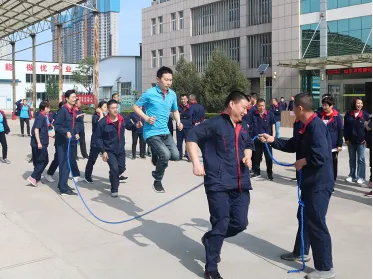The Survivalist's Guide to Rope: Which One is Best?
By definition, rope is simply any thick, long cord which is made by twisting or braiding together pieces hemp, sisal, nylon, or other materials.
There are a lot of ways to make rope, and some are far superior to others. Likewise, some materials are much more suitable for certain tasks. That is why it is so important that you know how to choose rope.
Rope Materials
Nylon
This is the best material for most rope uses. It is very strong. It also has a lot of stretch to it, which means it can absorb shock. It also does not mildew.
The downsides of nylon rope are that the material does not float, it loses its strength when wet (about 15-25% of its strength!), and the stretchiness is not always preferable.
Polyester
Polyester is another synthetic rope material. It is almost as strong as nylon, but without as much stretch.
Its main benefit compared to nylon is that it doesn’t lose strength when wet, so it is a good choice for uses like boat towing lines or anchors.
The downsides of polyester as a rope material are that it gets slippery, it can get mildew, doesn’t float, and will fray when cut.
Propylene
Propylene is often used as a cheap alternative to nylon in braided ropes. Aside from being cheap, its other benefits are that it floats and is very lightweight. It doesn’t stretch much, which makes it suitable for some purposes – like a ski tow line.
However, its many downsides include that it isn’t very strong and it degrades in UV lights (sunlight).
Natural Fibers (Hemp, Sisal, Cotton, etc)
Originally ropes were made out of natural fibers like hemp, and you can even make your own natural fiber rope in a survival situation out of plants you find.
The strength of the natural fiber rope depends largely on its construction, though some fibers are better than others. The main benefit of natural fibers is that they are cheap.
However, they have drawbacks like being susceptible to rot and mildew, fraying, and shrinking when they get wet.
Rope Construction
Ropes can be made in numerous ways, but we can break them all down into three categories: twisted rope, braided ropes, and kernmantle rope.
Twisted Rope
This was the most common rope throughout history. It was normally made with 3 strands that were twisted together. They are made by first spinning fibers into yarns. The yarns are then spun into strands. And finally the strands are spun into rope.
If you have rope with an obvious twist and tends to twist in one direction when you put it down, then this is twisted rope.
Braided Rope
When a rope is well braided, it will have many fibers which are all aligned in the same direction. This means that the rope will stay straight (instead of twisting in one direction like with twisted ropes).
The braid also means more fibers are intertwined in a smaller space, which adds strength.
Have you ever tried a Chinese finger trap? Well, that is a good example of how braiding can produce amazing strength. And, just like the Chinese finger trap, the more you pull on the rope, the stronger it gets.
There are 3 main kinds of braided rope:
- Single braid rope: These types of ropes are made by braiding strands together (usually 8 or 10) into a tubular shape. The rope will be hollow in the middle.
- Double braid rope: This type of rope is actually made from two single braid ropes. One of the braided ropes goes inside, and the other is braided around the first. The inner and outer ropes may be made out of different materials.
- Solid braid rope: These are made with a special lock-stitch which allows for a very dense rope that is not hollow in the middle. Solid braid ropes are generally very strong and resist abrasion well.
Kernmantle Rope
Kernmantle rope is a special type of rope which has a twisted core (the kern) and a braided shell. The kern is what gives the rope strength, and the outer shell gives it properties like resisting abrasion.
Depending on the material of the core, kernmantle can be stretchy or have little stretch. Stretchy kernmantle is known as “dynamic” and un-stretchy kernmantle is known as “static.”
Paracord is an example of kernmantle rope (read about paracord for survival and paracord strength). Rock climbing rope is also an example of kernmantle rope.
Paracord vs. Nylon Rope
Real paracord is made from nylon. However, not all nylon rope is paracord. For a rope to be considered paracord, it must have a kernmantle construction of a braided sheath around core yarns and also must meet certain specifications for weight, stretch and strength.
By contrast, there are many different types of nylon rope ranging from cheap nylon twine to high-strength nylon climbing ropes.
Paracord vs. Polypropylene Rope
Paracord is considered one of the all-around best types of rope for various utilities because it is strong, abrasion-resistant and shock-resistant. However, the nylon fibers in paracord weaken when wet. By contrast, polypropylene rope retains its strength when wet and thus is often a better choice for tasks where the rope will get wet.
Choosing Rope
Before you head to the hardware store or shop online for rope, make sure you know what characteristics to look for!
This is especially true when you are buying rope for survival or outdoor purposes. Since you are relying on this rope in case you need to make a lifeline, tie a splint, or any of the many other survival uses for rope, you better make sure you have a rope you can count on.
Here are the key qualities of rope you should look for.
- Tensile Strength: This is the amount of force that the rope can withstand before breaking. Note that tensile strength often refers to the amount of static force and not dynamic force that the rope can withstand. If you need a rope for towing a car, for example, then you’d want to get a tow strap (not really a rope) with a tensile strength of 20,000 pounds.
- Working Load: This is the maximum weight you can safely put on the rope. It is usually just a fraction of tensile strength. The reason is because even lightweight objects can exert a lot of force if they are in motion.
- Elongation: This refers to the amount of stretch that a rope has. Stretchy ropes will absorb some of the shock. This is very important for some purposes, such as with rock climbing. Or, think how stretchy bungee jumping rope is. By contrast, for applications like rappelling, you’d want a rope which isn’t stretchy.
- Weight: A heavier rope is going to be stronger than a lighter rope of the same material and construction. When trying to cut weight from your backpack, you will have to balance the need for strength with the weight constraints of the rope.
- Number of Yarns and Strands: Rope is made by twisting the material into yarns, and then the yarns are twisted into strands. The size and strength of the rope will vary depending on the number of yarns and strands.
For survival and wilderness situations, 550 paracord is considered the best. It is very strong, lightweight, resistant to abrasion, has a good amount of stretch (which is important for absorbing shock), and resists mildew. But paracord might be too pricy if you are looking for rope for tasks like, say, tying bales of hay together. Paracord is also not strong enough for tasks like climbing, rappelling or rescue.
What types of rope do you use? Let us know in the comments below.
Rope material
Synthetic fibers have different shapes that influence their characteristics and performance. Monofilaments are endless thick fibers with a stiff structure that offer very good abrasion resistance and low dirt take-up. Multifilaments are a bundle of thin fibers which are processed into twines before braiding a rope out of them. Most fibers follow this design which leads to high flexibility and tensile strength. Textured fibers are based on natural fibers and show a certain degree of disorder which gives the fibers good grip and high elasticity. The last type of fibers are Staple fibers which consist of spun pieces of short filaments. This construction gives the fiber excellent grip and soft handling.
Raw Material
Nylon (NY) / Polyamide (PA)
Polyamide or better known under its trade name Nylon, has high breaking load as well as high elongation. Preferably, it is used in products that are required to absorb shock loads like dynamic climbing ropes. The abrasion resistance of nylon is better in wet conditions than in dry conditions because it tends to take up water (up to 7%). Kept in wet conditions for too long, the material can become stiff. Another disadvantage compared to polyester is the lower resistance to UV-radiation in sunlight.
Polyester (PES)
Polyester is mainly used for static ropes because Polyester is characterized by good breaking loads and low stretch. This material offers both chemical and physical advantages such as UV resistance salt water resistance, and good abrasion strength in both dry and wet conditions. However, the dynamic energy absorption capacity is much lower than that of nylon ropes and therefore only to a limited extent suitable for types of use involving high impact forces.
Ultra High Molecular Weight Polyethylene (UHMWPE)
UHMWPE (also known as UHMPE or HMPE Dyneema®) is an extremely high strength fiber of ultra high molecular polyethylene. For the same weight it has 15 times the tensile strength of steel. Rope or slings made from this type of fiber shows very low elongation and tensile strength. If very high loads are being applied for a long period of time, UHMWPE fiber tends to creep. The rope then is irreversibly extending its length. At the same time, these robust fibers show excellent performance in terms of abrasion resistance and good UV-resistance.
Aramid (Aromatic Nylon)
Aramid fibers have an extremely high breaking load and show almost no stretch. On the other hand they are sensitive to UV-rays, bending over sharp edges, and abrasion. It is mainly used in places where high temperature resistance and abrasion is essential, for example on winches, in hot air balloon ropes or for canyoneering where the rope is nearly always in contact with rough stones.
Polypropylene (PP)
Due to its limited technical characteristics, polypropylene is only used for simple applications. PP is very light and even buoyant in water, that’s why it is used for water throwlines. Its abrasion resistance and temperature resistance are lower than those of most other fibers.
The advantages of polypropylene rope - Ropes Direct
Need a rope that’s suitable for outdoors? Perhaps one that can handle water?
Our polypropylene ropes could be an excellent choice.
At RopesDirect, we currently stock the traditional bestseller – blue polypropylene – as well as polypropylene ropes and cords in a range of other colours. These are classed as ‘general purpose’ ropes, suitable for domestic, commercial and leisure-based applications. And they boast a wide range of beneficial features, which make them a savvy option for use in the great outdoors.
6 advantages of polypropylene rope
- Robust construction
Polypropylene rope is well-known for its strength and durability.
Not only is it made from polypropylene (i.e. an incredibly robust plastic), it also benefits from a tight three-strand construction – which maximises its inherent strength and makes it very hard-wearing. The rope won’t splinter during use. And even if it is frequently knotted and untied, it will successfully withstand the wear and tear and last for many years.
- Rot-proof
This is one of the main reasons why polypropylene rope is perfect for use outdoors.
It’s both rot-proof and resistant to mildew, mould, acids, and alkalis. Whilst other rope fibres would soak up the moisture and decay in storage (e.g. due to bacterial growth), polypropylene is completely immune to the effects of water. Even if subject to extreme weather conditions or kept in a severely damp environment, the rope will maintain its strength and integrity for a very long time.
- Floats on water
Compared to water, which has a specific gravity rating of 1, polypropylene rope has a specific gravity of 0.91. As a result, it floats on the surface and doesn’t shrink, swell or change shape when wet.
Again, this makes it particularly useful for water-based applications, such as sailing or fishing. The rope can be easily spotted – even against the dark backdrop of water – and can be used for rescue lines, mooring and towing, directing and guiding boats, and marking out specific areas in the water.
- User-friendly
Despite their strength and resilience, polypropylene ropes are relatively lightweight. They also have a smooth finish (which doesn’t splinter), they hold knots very well, and are typically sold on handy bulk reels with heat-sealed ends. As such, they’re incredibly user-friendly and easy to handle.
- High visibility
Polypropylene ropes are most commonly sold in blue, black and beige. But a range of other, brighter colourways is also now available. For example, here at RopesDirect, we currently stock them in red, orange, green, white and yellow as well – and these are a fantastic option for outdoor use.
Such eye-catching shades significantly improve visibility, allowing the rope to be seen in low-light conditions, harsh weather and against the darkness of a deep body of water.
- Versatile
Last but not least, polypropylene ropes come in a broad spectrum of diameters, from 4mm – 32mm.
This diameter determines the rope’s capabilities in terms of strength and load capacity. And with such a wide selection to choose from, the product is versatile and adaptable – and can be used for a diverse range of home and business-based applications.










